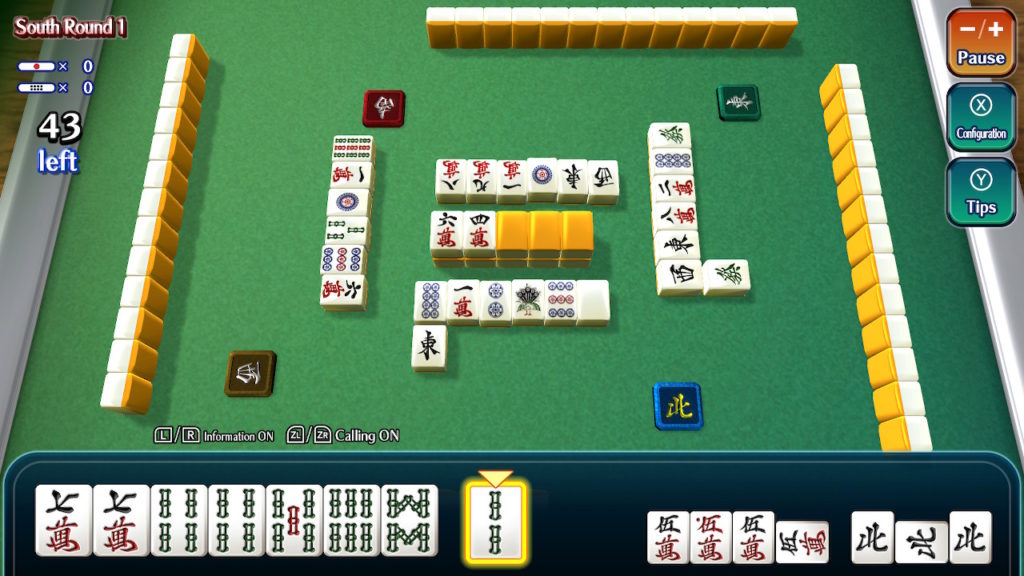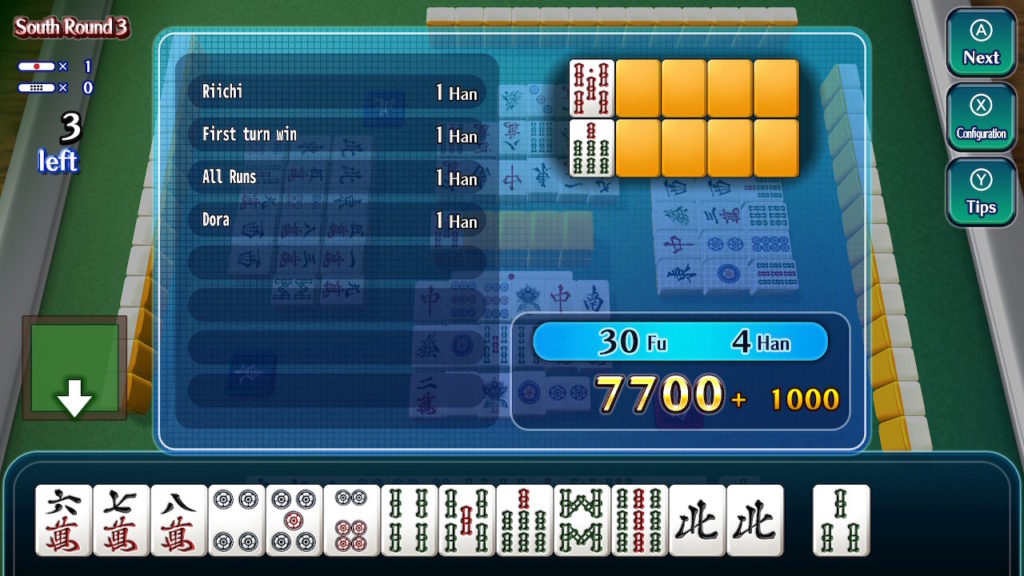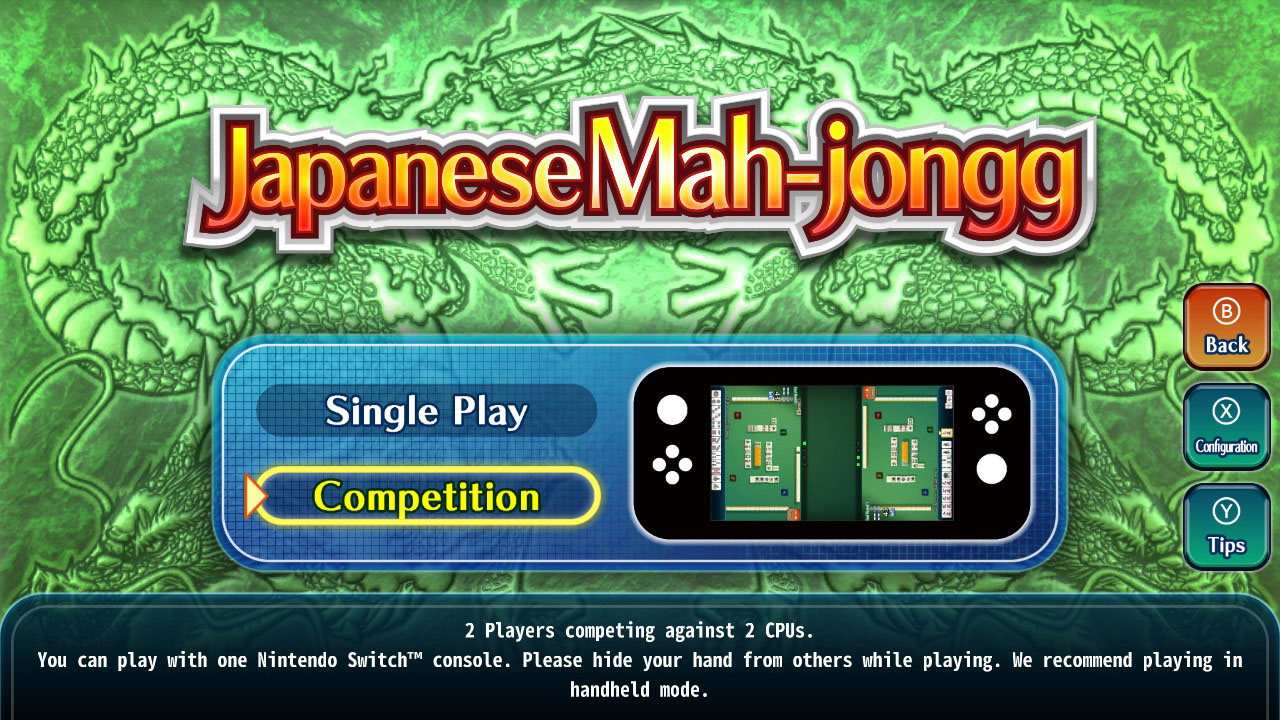I’m not as big a collector of Mahjong games as my boyfriend is; he has a really impressive collection of both import and domestic games for the SNES (even leaving the solitaire mahjong games aside, there’s an impressive number). But, even though I am nothing more than a beginner, I do like playing the game and am always looking out for something new.
While standing in line for Stellazzio Virtual Theater’s production of “Phantom of the Opera” last night (their productions are held entirely within Final Fantasy XIV, making them the perfect socially-distanced night on the town), I grew bored with waiting and chatting with my FC and picked up my Switch.
I wondered how good the mahjong games were on the Switch. I’d never actually seen one. There were a dozen solitaire Mahjong games, but then this one, Japanese Mah-jong, and it was just what I was looking for.

I’ve blogged about Mah-jong a few times before, so I won’t go too deeply into the game. Basically, it’s like rummy as played with playing cards, but with three suits instead of four. There’s some extra tiles, the honor tiles, that represent the four winds and the three dragons (green, red and white). In Japanese, or Riichi, Mah-jong, you also have a separate pool of tiles, the “dead wall”, that display the “dora”, or an indicator of another tile (the next in the sequence) that will give extra points at the end. And, some regular tiles and entirely in red, which are worth more points.
Anyway, the important thing to remember about Mah-jong is that there’s a couple dozen win conditions, called “yaku”, which are worth a certain number of multipliers, called “han”. It’s a lot to remember, and one thing I really, really liked about this version of Mah-jong is the reference guide it gives you up front.
I read through this a few times. We’d been watching a Mah-jong anime called “Saki“. The anime isn’t all that realistic, but there’s stuff I picked up from it. The importance of holding a ready hand until you can make it worth as many points as possible. It’s tempting to just call win as soon as you can, but if you’re behind on points, that may not be the best move. There’s no point in winning a hand and still losing the game.

The number one thing that anime showed me was how important it is to know what tiles you’re waiting for — your “waits” — and to know when to change those waits to better ones. (One of the players in the anime always chooses risky, but high-scoring waits).
A game of mah-jong can take eight hands or more, and I hadn’t finished the game by the time I was able to enter the theater, so I finished it this morning. And… I won. I was pretty excited 🙂
So, good game, great introduction to Mah-jong. You can play it with another person as well, passing the Switch from back to forth with the game playing the other two seats, or solo, as I did. Each AI player has one of several playing personalities that you can choose from, which will influence how risky they play. One will try to go for high point wins, one will try for riskier waits, etc. It’s disappointing that they use Chinese characters for the numbers — that could be a barrier for some. Even though this is Japanese mah-jong, they use the Chinese words for the various plays, but also use English for the super high-scoring “yakuman” plays (they call them “grand slams”).
The game supports English, Japanese and Chinese. I may try Japanese and see if they then use the Japanese words for the plays. The game was listed at $5, but with the points I had with the store, it ended up costing me less than two dollars.
Definitely a good value.
First hand explanation
- Pair 7s of characters (dora)
- 4, 4, 5, 6, 8 of bamboo (2 of bamboo drawn)
- Four (kan) of 5 of character (dora and one value tile)
- Three north winds (my wind as I am sitting north)
- I had two waits — 4 and 7 of bamboo, one wait from a ready hand.
I lost this hand, but it would have been a lot of points if I’d won it.
Second hand explanation
This was the final hand of the game, and I won both the hand and the game.
- 6, 7, 8 of characters
- 4, 5, 6 of circles
- 3, 4, 5 and 7, 8, 9 of bamboo (8 was dora)
- Pair of North winds
Riichi — I called ready on a concealed hand
First turn win — I won the same turn I called riichi
All runs — all my melds were runs, and no threes of a kind
Dora — for using the 8 of bamboo in one of my runs
I was initially trying for repeated runs — 4, 5 and 6 in all three suits, but that didn’t work out. You have to play with the tiles you draw. The game kept trying to make me open my hand, but having the 7, 8, 9 of bamboo meld and the pair of winds meant I couldn’t go for the (usually easy) “all simples” win, where you don’t use any 1s, 9s, or honor tiles. Keeping your hand concealed when you don’t have an obvious path to a better win is a good defensive play, as a concealed hand is always a win condition.




